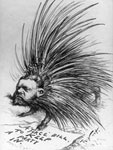Realizing the Value of Primary Sources
Question

My middle school students prefer to read secondary sources. How can I explain that primary sources are also valuable in understanding historical events?
Answer
What an interesting question! It provokes other questions—what is it about secondary sources that your students like? And what kinds of secondary sources do they like? Textbooks and movies are a familiar genre for students in middle school and offer a much tidier story than reading primary sources. Primary sources, given their variety, seem very different from these; and may offer challenges to your students that they are reluctant to tackle. Consider that primary sources about the same event can directly contradict, that they can contain antiquated or complex prose, and that the background knowledge necessary to understand a primary source can be substantial; and it definitely makes sense that your students balk at using them.
But this complexity, and the need to analyze and read them carefully, is exactly why your students need to work with them.
So what to do? While explaining to your students the value and importance of primary sources is one approach, combining that explanation with a few activities designed to show, rather than tell, students their importance can be invaluable. Some teachers do activities designed to make the nature of history more explicit for their students. These can range from activities that use everyday situations to uncover the existence of multiple contrasting sources about events to those that require students to investigate a historical question by consulting multiple sources. Both kinds of activities can be used to make points about differences and relationships between primary and secondary sources and the necessity of consulting primary sources to understand history.
For example, "everyday" activities could include:
- Students write accounts of the first day of class or school, teacher selects some to read, and then the class discusses why and how they differ. If a school newsletter addressed the beginning of school, use this to introduce secondary accounts into the activity.
- Stage a brief dramatic episode (for example, a verbal altercation) with a colleague and then have students write what happened. Compare accounts, generate questions that need to be asked of the accounts, and then consider how these interact with a hypothetical account of the same from the school newspaper—the secondary account in this activity.
- Read, analyze, and compare conflicting accounts of a community event that you find in the school or local newspaper. Identify what primary sources were consulted and the role they play in the story the newspaper tells.
More historical activities include:
- Do an Opening Up the Textbook lesson where students work with primary sources and their textbook and consider the role each plays in telling the story of the past.
- Use a lesson like the one reviewed here about the Boston Massacre to help students understand that primary sources are the raw materials of history.
- Or try an activity structure like this one for analyzing photographs or this one for writing structured academic controversies to meaningfully engage students with primary sources.
Using detective work as a metaphor for introducing primary sources and the central role they play in creating those secondary accounts can be useful. See this Research Brief or this one for a quick look at studies that included teaching students what primary sources were and how they were used by historians.
You may also get buy-in from your students if you select primary sources that you judge especially interesting for them. For example, try using childrens’ voices from the past (See this Depression Era lesson or this Civil War lesson.) or sources addressing topics they are interested in like music or sports.
But in any case, even if students are initially resistant to primary sources in your classroom, we encourage you to use them and help them learn why studying history without them makes little sense as they are the raw materials of the discipline. Primary sources also offer rich opportunities for helping your students practice and hone their reading and analysis skills, critical abilities for their future.
